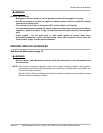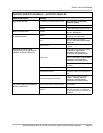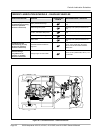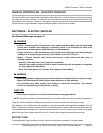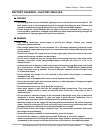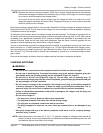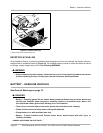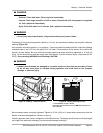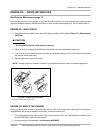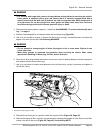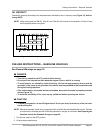
Battery Charger – Electric Vehicles
Page 40 2008 Husqvarna 4210-G, 4210-E, 4210-GXP, and 4210-EXP Owner’s Manual
NOTE: Because the vehicle’s onboard computer (OBC) has a storage charge feature that automatically
checks and recharges the batteries as necessary every 15 days, the charger can remain plugged
to an electric vehicle throughout the storage period.
At one hour and at two hours into the charge cycle, the charger will shut off in order to run a self-
diagnostic program (ammeter will drop to zero). Charging will resume in a few moments (ammeter
returns to previous rate of charge).
Each electric vehicle is supplied with a fully automatic PowerDrive 2 battery charger as standard equipment
(Husqvarna 603 00 20-09). The AC cord to each charger is to be connected to a source capable of supplying
15 amperes minimum per charger.
To reduce the risk of electric shock, the battery charger must be grounded. The charger is equipped with an
AC electric cord having an equipment-grounding conductor and a grounding type plug. The AC plug must be
connected to an appropriate receptacle that is properly installed and grounded in accordance with the
National Electrical Code and all local codes and ordinances. See the owner’s manual supplied with the
charger for specific operating instructions before using the charger.
The use of an extension cord with the charger should be avoided. If an extension cord must be used, use a
three-conductor no. 12 AWG (American Wire Gauge) or no. 14 SWG (British Standard Wire Gauge), heavy-
duty cord with ground, properly wired and in good electrical condition. Keep it as short as possible (no more
than 12 feet (3.7 m)). Place all cords so they will not be stepped on, tripped over, or otherwise subject to dam-
age or stress.
Ensure that the charger ventilation slots are unobstructed and that there is adequate ventilation.
CHARGING BATTERIES
ý WARNING
• Be sure all wire connections at the receptacle and the fuse link are clean and tight.
• Do not rock or bend the plug. To connect the charger plug to the vehicle receptacle, grasp the
plug handle and push the plug straight into the receptacle (Figure 22, Page 41).
• Do not pull on the DC cord (Figure 23, Page 41). Do not twist, rock or bend the plug. To
disconnect the charger plug from the vehicle receptacle, grasp the plug by the handle and pull
the plug straight out of the receptacle.
• Do not connect a charger to the receptacle if the charger cord, plug, or the vehicle receptacle
is broken, damaged in any manner, or does not make a good electrical connection. Fire or
personal injury can result. Have it replaced by a qualified service person immediately.
• Failure to follow these instructions could result in damage to the charger cord, the plug, and
(or) the vehicle receptacle.
• Do not use a charger if:
- The plug is too loose or does not make a good connection.
- The plug and receptacle feel hotter than normal during charge.
- The plug pins or receptacle contacts are bent or corroded.
- The plug, receptacle, or cords are cut, worn, have any exposed wires or are damaged in any
way.
• Using the charger with any of the above symptoms could result in a fire, property damage,
personal injury, or death.
NOTE: When temperatures fall below 65 °F (18.3 °C), batteries charged in unheated areas should be
placed on charge as soon as possible after use. Batteries are warmest immediately after use, and
cold batteries require more time to fully charge.



